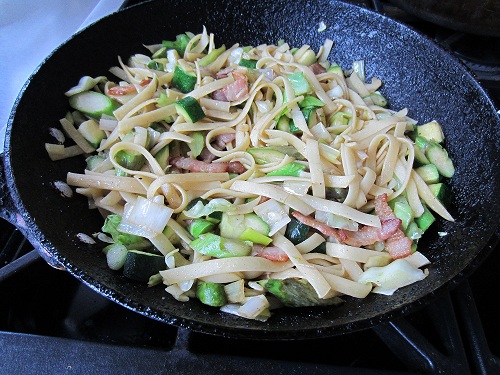Feeding the Landfill
 Monday, April 30, 2012 at 1:00AM
Monday, April 30, 2012 at 1:00AM  Fettuccini fried “rice”
Fettuccini fried “rice”
By Sandy Hu
Recently, The Wall Street Journal published a story called “Leftovers: Tasty or Trash?” in which the writer shared some eye-opening statistics:
- An average U.S. family of four throws away between $500 to $2,000 worth of food each year
- 25 percent of trash in a home (all avoidable waste) consists of vegetables
- 16 percent is fruits and juices
- 14 percent is grains
- 13 percent is milk and yogurt
Here’s another disturbing fact cited by the paper: After paper and paperboard, food is the next largest solid waste component in U.S. landfills and incinerators. A staggering 33 million tons of food was dumped in 2010 according to the Environmental Protection Agency.
Two weeks after Earth Day, I am still troubled by these statistics. In San Francisco, at least our food waste is composted. We carefully sort all our trash into three bins; blue for recycling, green for composting and black for unsalvageable trash. We take our own bags to the market and we recycle all the plastic bags we bring home from the produce department. In 2010, San Francisco’s diversion rate was 77 percent. That is, of all trash in the city, 77 percent was kept out of the landfill or incineration by recycling or composting.
The Wall Street Journal story focused on the financial impact – looking at leftovers and waste, coupled with higher food prices – from an economic context. And true, I don’t want to waste money. But I also care from the environmental standpoint. We commit tremendous resources to growing and processing food, shipping it, chilling it, stocking it – and then we throw it in the garbage.
I confess I waste food, too. Usually it happens because Steve and I are working late and neither of us has time to cook. Or because our fridge is too full of stuff leftover from Video Friday demos for Special Fork. We buy two or three times the ingredients called for in a recipe to enable us to shoot more than once, as needed. When our fridge is stuffed, I lose track of what’s inside.
Here are some things I know that help to prevent food waste:
- Keep the fridge clean and have everything labeled. Out of sight is out of mind. Inventory what’s at hand on a sheet of paper or in a notebook. Coss out items as you use them and add foods as you buy them.
- My daughter-in-law Lynn suggests making your refrigerator inventory list on a whiteboard that can be posted in your kitchen, enabling easy updating.
- To maximize refrigerator space, buy rectangular or square storage containers instead of bowl-shaped ones.
- Cooked food will keep longer than raw. So if you don’t have time to cook that ground beef for dinner, but can take just enough time to brown the meat and chill it, you’ve bought yourself a few more days to make chili or tacos later.
- In our family, if we have poultry pieces that aren’t going to get cooked right away, we salt and pepper and grill them to turn into chicken salad or Chicken Tetrazzini when we can.
- When I have bits of leftovers – raw veggies and/or cooked meat like leftover steak, I cut everything up and make fried rice or a soup. Recently, I had some leftover fettuccine but no leftover sauce, so I made a version of fried “rice” by sautéing some cut-up bacon and diced leftover veggies, I rough-chopped the mound of cold pasta and tossed it into the wok, then seasoned with soy sauce and a hit of sesame oil. It was really quite good and tasted like Chinese noodles from our takeout place.

What are your best ways to prevent food waste? Please share your ideas so we can all do better.
I am no model environmental citizen. But I do feel bad when I waste. And I do try. It’s a start.
Special Fork is a recipe website for your smartphone and PC that solves the daily dinnertime dilemma: what to cook now! Our bloggers blog Monday through Friday to give you cooking inspiration. Check out our recipe database for quick ideas that take no more than 30 minutes of prep time. Join the conversation on Facebook and follow us on Twitter.
Related posts:
Reader Comments (1)
This is a really important topic. The first step is to be conscious of our waste habits. Consistent meal planning is one way to try to reduce waste. Good Housekeeping has a smart article here: http://t.co/38X36HPl
PS Sandy - I'm glad I'm not the only one who loses track of food in my fridge from work projects! Sad but true. I like your daughter in-law's white board suggestion.